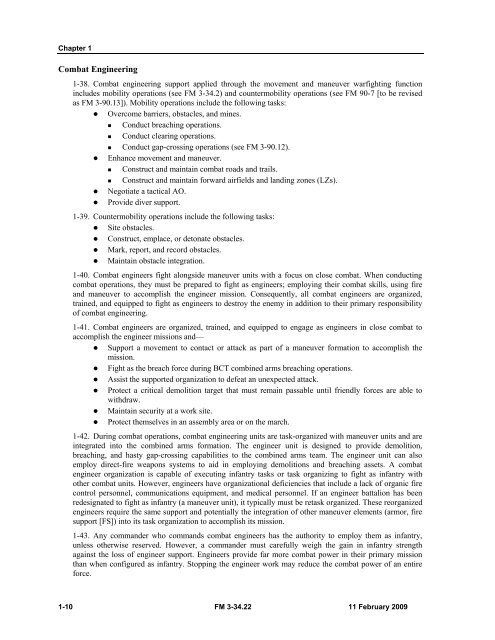FM 3-34.22 - Army Electronic Publications & Forms - U.S. Army
FM 3-34.22 - Army Electronic Publications & Forms - U.S. Army
FM 3-34.22 - Army Electronic Publications & Forms - U.S. Army
You also want an ePaper? Increase the reach of your titles
YUMPU automatically turns print PDFs into web optimized ePapers that Google loves.
Chapter 1<br />
Combat Engineering<br />
1-38. Combat engineering support applied through the movement and maneuver warfighting function<br />
includes mobility operations (see <strong>FM</strong> 3-34.2) and countermobility operations (see <strong>FM</strong> 90-7 [to be revised<br />
as <strong>FM</strong> 3-90.13]). Mobility operations include the following tasks:<br />
� Overcome barriers, obstacles, and mines.<br />
� Conduct breaching operations.<br />
� Conduct clearing operations.<br />
� Conduct gap-crossing operations (see <strong>FM</strong> 3-90.12).<br />
� Enhance movement and maneuver.<br />
� Construct and maintain combat roads and trails.<br />
� Construct and maintain forward airfields and landing zones (LZs).<br />
� Negotiate a tactical AO.<br />
� Provide diver support.<br />
1-39. Countermobility operations include the following tasks:<br />
� Site obstacles.<br />
� Construct, emplace, or detonate obstacles.<br />
� Mark, report, and record obstacles.<br />
� Maintain obstacle integration.<br />
1-40. Combat engineers fight alongside maneuver units with a focus on close combat. When conducting<br />
combat operations, they must be prepared to fight as engineers; employing their combat skills, using fire<br />
and maneuver to accomplish the engineer mission. Consequently, all combat engineers are organized,<br />
trained, and equipped to fight as engineers to destroy the enemy in addition to their primary responsibility<br />
of combat engineering.<br />
1-41. Combat engineers are organized, trained, and equipped to engage as engineers in close combat to<br />
accomplish the engineer missions and—<br />
� Support a movement to contact or attack as part of a maneuver formation to accomplish the<br />
mission.<br />
� Fight as the breach force during BCT combined arms breaching operations.<br />
� Assist the supported organization to defeat an unexpected attack.<br />
� Protect a critical demolition target that must remain passable until friendly forces are able to<br />
withdraw.<br />
� Maintain security at a work site.<br />
� Protect themselves in an assembly area or on the march.<br />
1-42. During combat operations, combat engineering units are task-organized with maneuver units and are<br />
integrated into the combined arms formation. The engineer unit is designed to provide demolition,<br />
breaching, and hasty gap-crossing capabilities to the combined arms team. The engineer unit can also<br />
employ direct-fire weapons systems to aid in employing demolitions and breaching assets. A combat<br />
engineer organization is capable of executing infantry tasks or task organizing to fight as infantry with<br />
other combat units. However, engineers have organizational deficiencies that include a lack of organic fire<br />
control personnel, communications equipment, and medical personnel. If an engineer battalion has been<br />
redesignated to fight as infantry (a maneuver unit), it typically must be retask organized. These reorganized<br />
engineers require the same support and potentially the integration of other maneuver elements (armor, fire<br />
support [FS]) into its task organization to accomplish its mission.<br />
1-43. Any commander who commands combat engineers has the authority to employ them as infantry,<br />
unless otherwise reserved. However, a commander must carefully weigh the gain in infantry strength<br />
against the loss of engineer support. Engineers provide far more combat power in their primary mission<br />
than when configured as infantry. Stopping the engineer work may reduce the combat power of an entire<br />
force.<br />
1-10 <strong>FM</strong> 3-<strong>34.22</strong> 11 February 2009

















